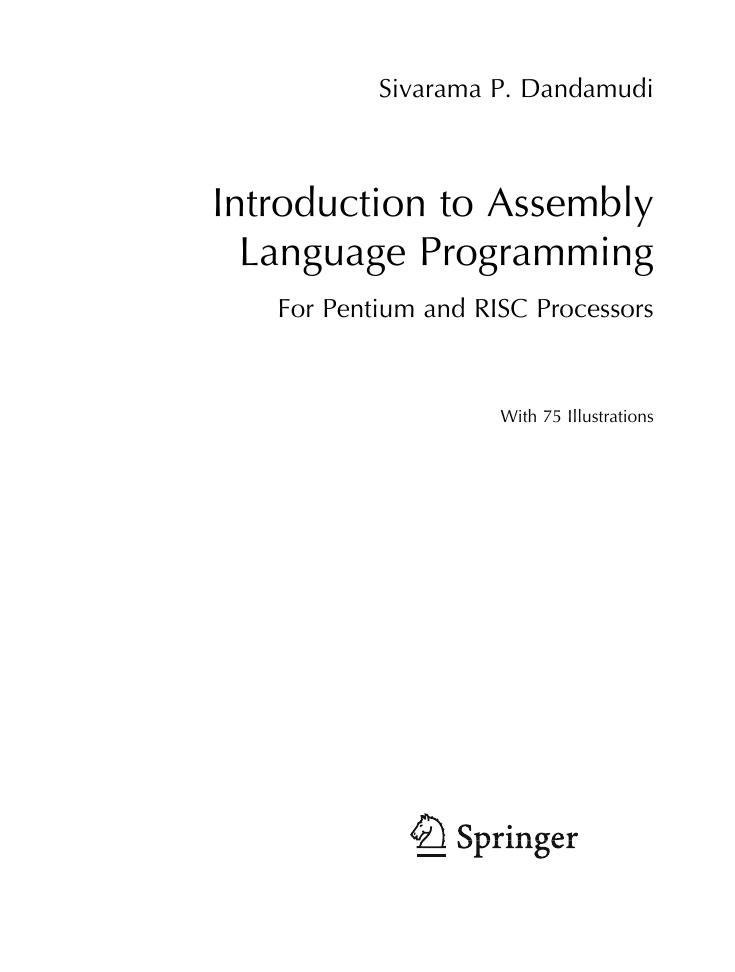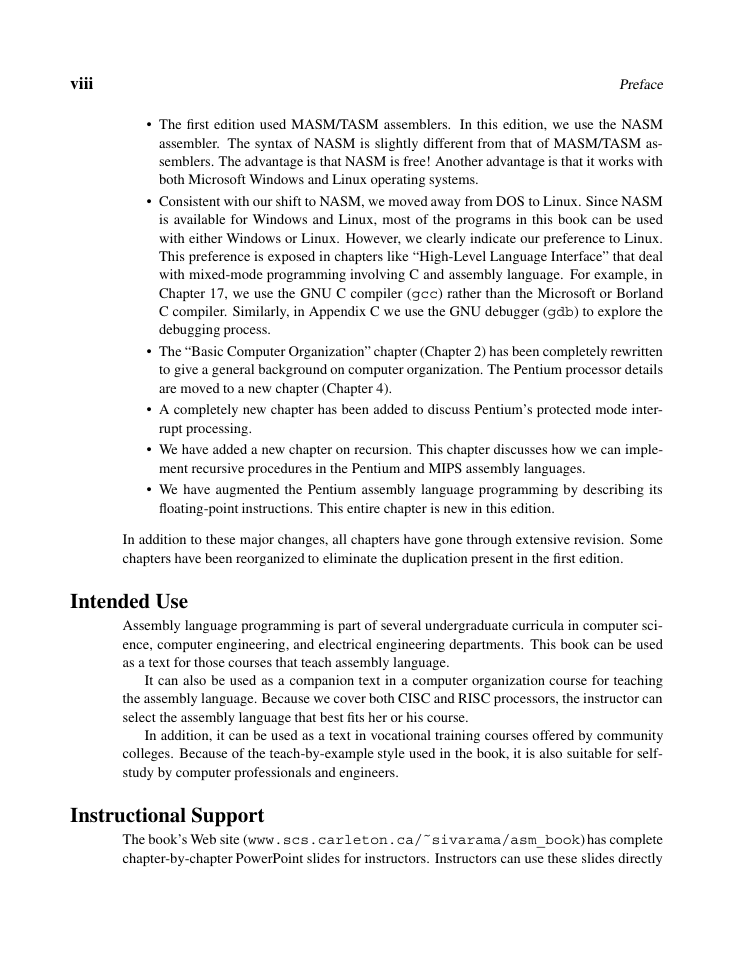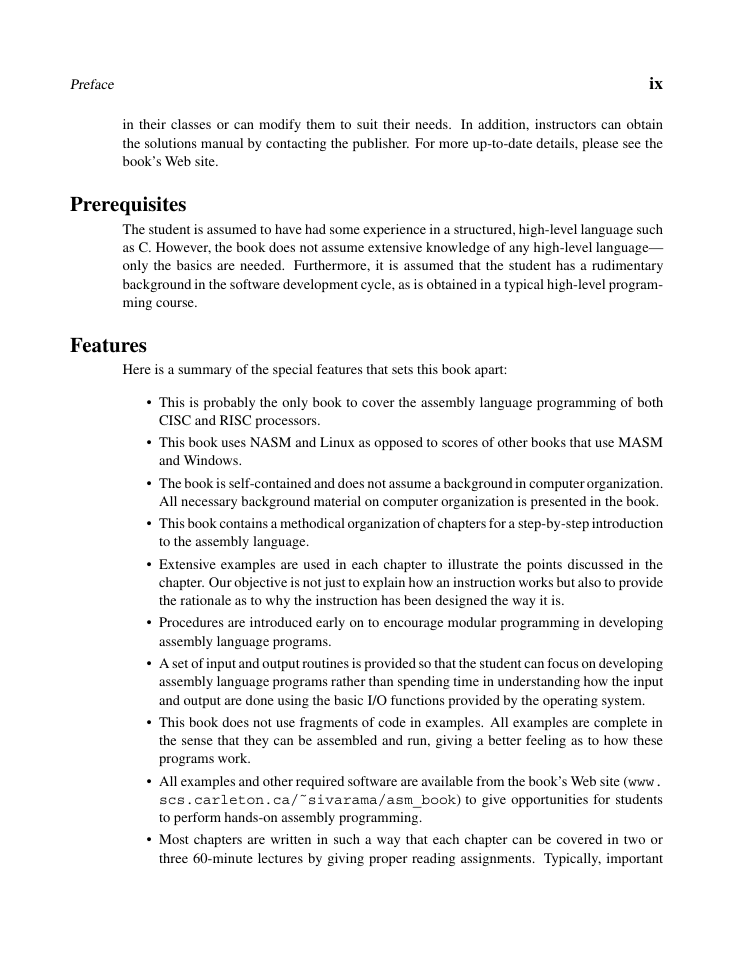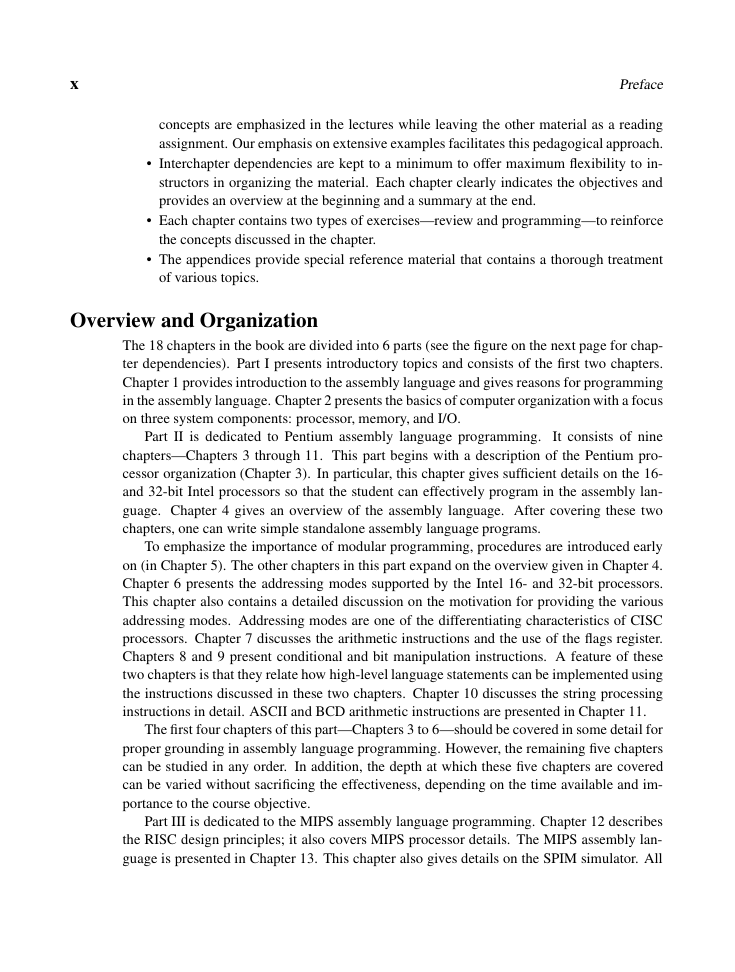TEXTS IN COMPUTER SCIENCE
Editors
David Gries
Fred B. Schneider
�
Sivarama P. Dandamudi
Introduction to Assembly
Language Programming
For Pentium and RISC Processors
With 75 Illustrations
�
Sivarama P. Dandamudi
School of Computer Science
Carleton University
1125 Colonel By Drive
Ottawa, K1S 5B6
Canada
sivarama@scs.carleton.ca
Series Editors:
David Gries
Fred B. Schneider
Department of Computer Science
Cornell University
Upson Hall
Ithaca, NY 14853-7501
USA
Library of Congress Cataloging-in-Publication Data
Dandamudi, Sivarama P., 1955–
Introduction to Assembly language programming : Pentium and RISC processors /
Sivarama P. Dandamudi.— 2nd ed.
p. cm. — (Texts in computer science)
Includes bibliographical references and index.
ISBN 0-387-20636-1 (alk. paper)
1. Assembler language (Computer program language) 2.
Microprocessors—Programming.
QA76.73.A87D36 2004
005.13′6—dc22
I. Title.
II. Series.
ISBN 0-387-20636-1
Printed on acid-free paper.
Pentium is a registered trademark of Intel Corporation.
2004049182
2005, 1998 Springer Science+Business Media, Inc.
All rights reserved. This work may not be translated or copied in whole or in part without the written permission of the
publisher (Springer Science+Business Media, Inc., 233 Spring Street, New York, NY 10013, USA), except for brief
excerpts in connection with reviews or scholarly analysis. Use in connection with any form of information storage and
retrieval, electronic adaptation, computer software, or by similar or dissimilar methodology now known or hereafter
developed is forbidden.
The use in this publication of trade names, trademarks, service marks, and similar terms, even if they are not identified
as such, is not to be taken as an expression of opinion as to whether or not they are subject to proprietary rights.
Printed in the United States of America.
(HAM)
9 8 7 6 5 4 3 2 1
SPIN 10949580
springeronline.com
�
my parents, Subba Rao and Prameela Rani,
To
my wife, Sobha,
and
my daughter, Veda
�
Preface
The objective of this book is to introduce assembly language programming. Assembly lan-
guage is very closely linked to the underlying processor architecture and design. Popular
processor designs can be broadly divided into two categories: Complex Instruction Set Com-
puters (CISC) and Reduced Instruction Set Computers (RISC). The dominant processor in
the PC market, Pentium, belongs to the CISC category. However, the recent design trend is to
use the RISC designs. Some example RISC processors include the MIPS, SPARC, PowerPC,
and ARM. Even Intel’s 64-bit processor Itanium is a RISC processor. Thus, both types of
processors are important candidates for our study.
This book covers assembly language programming of both CISC and RISC processors.
We use the Intel Pentium processor as the representative of the CISC category. We have
selected the Pentium processor because of its market dominance. To explore RISC assembly
language, we selected the MIPS processor. The MIPS processor is appealing as it closely
adheres to the RISC principles. Furthermore, the availability of the SPIM simulator allows us
to use a Pentium-based PC to learn MIPS assembly language.
New in the Second Edition
The second edition has been substantially revised to reflect the changes that have taken place
since the publication of the first edition. The major changes are listed below:
• We introduced RISC assembly language programming so that the reader can benefit
from learning both CISC and RISC assembly languages. As mentioned before, Pentium
and MIPS processors are used to cover CISC and RISC processors.
vii
�
viii
Preface
• The first edition used MASM/TASM assemblers. In this edition, we use the NASM
assembler. The syntax of NASM is slightly different from that of MASM/TASM as-
semblers. The advantage is that NASM is free! Another advantage is that it works with
both Microsoft Windows and Linux operating systems.
• Consistent with our shift to NASM, we moved away from DOS to Linux. Since NASM
is available for Windows and Linux, most of the programs in this book can be used
with either Windows or Linux. However, we clearly indicate our preference to Linux.
This preference is exposed in chapters like “High-Level Language Interface” that deal
with mixed-mode programming involving C and assembly language. For example, in
Chapter 17, we use the GNU C compiler (gcc) rather than the Microsoft or Borland
C compiler. Similarly, in Appendix C we use the GNU debugger (gdb) to explore the
debugging process.
• The “Basic Computer Organization” chapter (Chapter 2) has been completely rewritten
to give a general background on computer organization. The Pentium processor details
are moved to a new chapter (Chapter 4).
• A completely new chapter has been added to discuss Pentium’s protected mode inter-
rupt processing.
• We have added a new chapter on recursion. This chapter discusses how we can imple-
ment recursive procedures in the Pentium and MIPS assembly languages.
• We have augmented the Pentium assembly language programming by describing its
floating-point instructions. This entire chapter is new in this edition.
In addition to these major changes, all chapters have gone through extensive revision. Some
chapters have been reorganized to eliminate the duplication present in the first edition.
Intended Use
Assembly language programming is part of several undergraduate curricula in computer sci-
ence, computer engineering, and electrical engineering departments. This book can be used
as a text for those courses that teach assembly language.
It can also be used as a companion text in a computer organization course for teaching
the assembly language. Because we cover both CISC and RISC processors, the instructor can
select the assembly language that best fits her or his course.
In addition, it can be used as a text in vocational training courses offered by community
colleges. Because of the teach-by-example style used in the book, it is also suitable for self-
study by computer professionals and engineers.
Instructional Support
The book’s Web site (www.scs.carleton.ca/˜sivarama/asm_book) has complete
chapter-by-chapter PowerPoint slides for instructors. Instructors can use these slides directly
�
Preface
ix
in their classes or can modify them to suit their needs. In addition, instructors can obtain
the solutions manual by contacting the publisher. For more up-to-date details, please see the
book’s Web site.
Prerequisites
The student is assumed to have had some experience in a structured, high-level language such
as C. However, the book does not assume extensive knowledge of any high-level language—
only the basics are needed. Furthermore, it is assumed that the student has a rudimentary
background in the software development cycle, as is obtained in a typical high-level program-
ming course.
Features
Here is a summary of the special features that sets this book apart:
• This is probably the only book to cover the assembly language programming of both
CISC and RISC processors.
• This book uses NASM and Linux as opposed to scores of other books that use MASM
and Windows.
• The book is self-contained and does not assume a background in computer organization.
All necessary background material on computer organization is presented in the book.
• This book contains a methodical organization of chapters for a step-by-step introduction
to the assembly language.
• Extensive examples are used in each chapter to illustrate the points discussed in the
chapter. Our objective is not just to explain how an instruction works but also to provide
the rationale as to why the instruction has been designed the way it is.
• Procedures are introduced early on to encourage modular programming in developing
assembly language programs.
• A set of input and output routines is provided so that the student can focus on developing
assembly language programs rather than spending time in understanding how the input
and output are done using the basic I/O functions provided by the operating system.
• This book does not use fragments of code in examples. All examples are complete in
the sense that they can be assembled and run, giving a better feeling as to how these
programs work.
• All examples and other required software are available from the book’s Web site (www.
scs.carleton.ca/˜sivarama/asm_book) to give opportunities for students
to perform hands-on assembly programming.
• Most chapters are written in such a way that each chapter can be covered in two or
three 60-minute lectures by giving proper reading assignments. Typically, important
�
x
Preface
concepts are emphasized in the lectures while leaving the other material as a reading
assignment. Our emphasis on extensive examples facilitates this pedagogical approach.
• Interchapter dependencies are kept to a minimum to offer maximum flexibility to in-
structors in organizing the material. Each chapter clearly indicates the objectives and
provides an overview at the beginning and a summary at the end.
• Each chapter contains two types of exercises—review and programming—to reinforce
the concepts discussed in the chapter.
• The appendices provide special reference material that contains a thorough treatment
of various topics.
Overview and Organization
The 18 chapters in the book are divided into 6 parts (see the figure on the next page for chap-
ter dependencies). Part I presents introductory topics and consists of the first two chapters.
Chapter 1 provides introduction to the assembly language and gives reasons for programming
in the assembly language. Chapter 2 presents the basics of computer organization with a focus
on three system components: processor, memory, and I/O.
Part II is dedicated to Pentium assembly language programming.
It consists of nine
chapters—Chapters 3 through 11. This part begins with a description of the Pentium pro-
cessor organization (Chapter 3). In particular, this chapter gives sufficient details on the 16-
and 32-bit Intel processors so that the student can effectively program in the assembly lan-
guage. Chapter 4 gives an overview of the assembly language. After covering these two
chapters, one can write simple standalone assembly language programs.
To emphasize the importance of modular programming, procedures are introduced early
on (in Chapter 5). The other chapters in this part expand on the overview given in Chapter 4.
Chapter 6 presents the addressing modes supported by the Intel 16- and 32-bit processors.
This chapter also contains a detailed discussion on the motivation for providing the various
addressing modes. Addressing modes are one of the differentiating characteristics of CISC
processors. Chapter 7 discusses the arithmetic instructions and the use of the flags register.
Chapters 8 and 9 present conditional and bit manipulation instructions. A feature of these
two chapters is that they relate how high-level language statements can be implemented using
the instructions discussed in these two chapters. Chapter 10 discusses the string processing
instructions in detail. ASCII and BCD arithmetic instructions are presented in Chapter 11.
The first four chapters of this part—Chapters 3 to 6—should be covered in some detail for
proper grounding in assembly language programming. However, the remaining five chapters
can be studied in any order. In addition, the depth at which these five chapters are covered
can be varied without sacrificing the effectiveness, depending on the time available and im-
portance to the course objective.
Part III is dedicated to the MIPS assembly language programming. Chapter 12 describes
the RISC design principles; it also covers MIPS processor details. The MIPS assembly lan-
guage is presented in Chapter 13. This chapter also gives details on the SPIM simulator. All
�
















 2023年江西萍乡中考道德与法治真题及答案.doc
2023年江西萍乡中考道德与法治真题及答案.doc 2012年重庆南川中考生物真题及答案.doc
2012年重庆南川中考生物真题及答案.doc 2013年江西师范大学地理学综合及文艺理论基础考研真题.doc
2013年江西师范大学地理学综合及文艺理论基础考研真题.doc 2020年四川甘孜小升初语文真题及答案I卷.doc
2020年四川甘孜小升初语文真题及答案I卷.doc 2020年注册岩土工程师专业基础考试真题及答案.doc
2020年注册岩土工程师专业基础考试真题及答案.doc 2023-2024学年福建省厦门市九年级上学期数学月考试题及答案.doc
2023-2024学年福建省厦门市九年级上学期数学月考试题及答案.doc 2021-2022学年辽宁省沈阳市大东区九年级上学期语文期末试题及答案.doc
2021-2022学年辽宁省沈阳市大东区九年级上学期语文期末试题及答案.doc 2022-2023学年北京东城区初三第一学期物理期末试卷及答案.doc
2022-2023学年北京东城区初三第一学期物理期末试卷及答案.doc 2018上半年江西教师资格初中地理学科知识与教学能力真题及答案.doc
2018上半年江西教师资格初中地理学科知识与教学能力真题及答案.doc 2012年河北国家公务员申论考试真题及答案-省级.doc
2012年河北国家公务员申论考试真题及答案-省级.doc 2020-2021学年江苏省扬州市江都区邵樊片九年级上学期数学第一次质量检测试题及答案.doc
2020-2021学年江苏省扬州市江都区邵樊片九年级上学期数学第一次质量检测试题及答案.doc 2022下半年黑龙江教师资格证中学综合素质真题及答案.doc
2022下半年黑龙江教师资格证中学综合素质真题及答案.doc